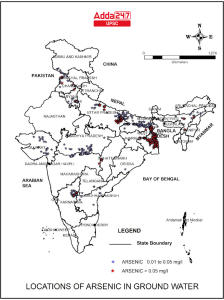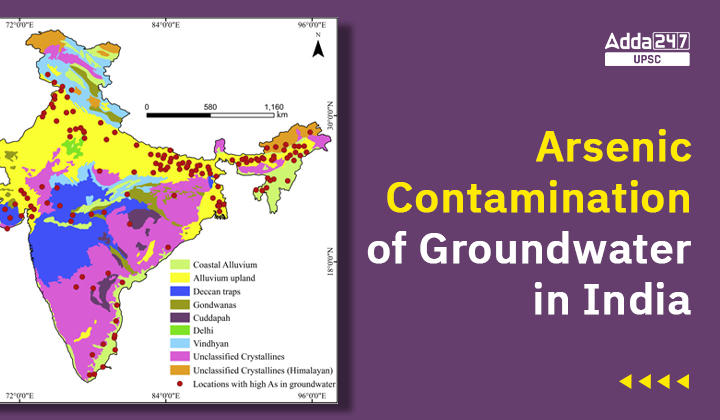Table of Contents
Context: A recent study has revealed that elevated levels of arsenic have been detected in groundwater across 18 districts of Bihar. This finding has also established a significant correlation between the high arsenic concentrations and the occurrence of gallbladder cancer in these regions.
Introduction
Arsenic Contamination in Groundwater: The occurrence of arsenic in groundwater in India, particularly in West Bengal, has been a cause of concern since it was first reported in 1980. Arsenic contamination in groundwater poses a significant health risk to the population, and its impact on cognitive functions has raised alarm bells. This article delves into the extent of arsenic contamination in various states of India, its health implications, and potential solutions to mitigate the crisis.
Extent of Arsenic Contamination
In West Bengal, 79 blocks in 8 districts have recorded arsenic levels beyond the permissible limit of 0.05 mg/l. The most affected areas lie on the eastern side of the Bhagirathi River in districts like Malda, Murshidabad, Nadia, North 24 Parganas, and South 24 Parganas. On the western side, Howrah, Hugli,
and Bardhman districts also face significant arsenic contamination. However, deeper aquifers remain free from arsenic, offering a potential solution.
Aside from West Bengal, arsenic contamination has also been observed in other states such as Assam, Bihar, Chhattisgarh, Haryana, Jharkhand, Karnataka, Punjab, and Uttar Pradesh. In Bihar, West Bengal, and Uttar Pradesh, arsenic contamination occurs in alluvial formations.
In Chhattisgarh, it is predominantly found in volcanic rocks within the N-S trending Dongargarh-Kotri ancient rift zone. Additionally, districts in Assam, including Golaghat, Jorhat, Lakhimpur, Nagaon, Nalbari, Sibsagar, and Sonitpur have reported arsenic contamination.
Arsenic Contamination Health Implications and Key Findings
Studies have highlighted the dire consequences of chronic arsenic poisoning, leading to a ‘silent pandemic’ affecting a significant portion of the population. Exposure to arsenic has been linked to reduced grey matter in the brain, resulting in weaker cognitive functions such as concentration, task switching, and temporary information storage. Economically and nutritionally disadvantaged individuals are particularly susceptible to higher cognitive damage due to arsenic exposure. Food intake is a major contributor to arsenic exposure in many parts of India, with rice consumption being a key factor. South India, including areas like Rishi Valley and Bangalore, has shown higher mean arsenic levels due to widespread rice consumption. This highlights the need to address arsenic levels not
only in groundwater but also in food sources.

Potential Solutions and the Way Forward
Addressing the arsenic contamination crisis requires a multi-faceted approach. Here are some potential solutions:
- In-situ remediation: Decontamination of arsenic-infested aquifers to eliminate arsenic from the water source.
- Ex-situ treatment: Utilizing arsenic removal devices for treating groundwater before consumption.
- Diversifying water sources: Exploring the use of surface water sources as alternatives to contaminated groundwater.
- Appling into deeper aquifers: Exploring the potential of accessing deeper aquifers that are arsenic-free for a safer water supply.
- Promoting rainwater harvesting: Raising awareness and encouraging individuals to invest in rainwater harvesting as an alternative water source.
- Monitoring irrigation water quality: It is essential to monitor the quality of irrigation water alongside drinking water to reduce exposure to arsenic.
- Strengthening canal systems: Reducing farmers’ reliance on groundwater by improving and expanding the canal system for irrigation purposes.
Conclusion
The presence of arsenic in groundwater across various states in India poses a severe threat to public health. It is crucial to address this silent pandemic through sustained efforts, including remediation measures, alternative water sources, and increased awareness. By implementing comprehensive solutions, India can mitigate the adverse effects of arsenic contamination, ensuring a safer and healthier future for its citizens.
| Follow US | |
| UPSC Govt. Jobs UPSC Current Affairs UPSC Judiciary PCS Download Adda 247 App here to get the latest updates |



 TSPSC Group 1 Question Paper 2024, Downl...
TSPSC Group 1 Question Paper 2024, Downl...
 TSPSC Group 1 Answer key 2024 Out, Downl...
TSPSC Group 1 Answer key 2024 Out, Downl...
 UPSC Prelims 2024 Question Paper, Downlo...
UPSC Prelims 2024 Question Paper, Downlo...
